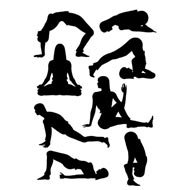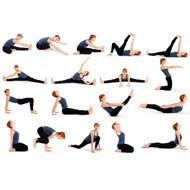- Raja yoga
- Yoga Stretches
- Jivamukti Yoga Poses
- Yoga Tree Pose
- Sun and Moon Yoga
- Wind Removing Pose
- Hare Pose
- Accomplished Pose
- Urdhva Mukha Pinch Mayurasana
- Revolved Abdomen Pose
- Raised Foot Pose
- Scorpion Pose
- Butterfly Pose
- Half Tortoise Pose
- Revolved Twist
- Balancing Stick Pose
- Cat Pose
- Supported Shoulderstand
- Crane Pose
- Handstand
- Happy Baby Pose
- Firefly Pose
- Scale Pose
- Side Plank Pose
- Upward Facing Two-Foot Staff Pose
- Reclining Big Toe Pose
- Stick Pose
- Revolved Head-to-Knee Pose
- Full Boat Pose
- Upward Extended Feet Pose
- Yoga arm balance poses
- Core Yoga
- Inversion Yoga Poses
- Seated And Twist Yoga
- Horse Pose
- Cobbler Pose
- Seated Wide Angle Pose
- The Compass Pose
- Half Crow Pose
- Bound Half Moon Pose
- Lotus Pose
- Reverse Warrior Pose
- Fixed Firm Pose
- Back-bend Poses
- Forward bend Poses
- Sarvangasana
- Warm up poses
- Seated Poses
- Seated Forward Bends
- Chair Poses
- Standing Poses
- Standing Balancing poses
- Yoga Asanas
- Hatha Yoga Asanas
- Yoga Postures Online
- Partner Yoga Poses
- Anusara Yoga Poses
- Advanced Yoga poses
- Restorative Yoga Poses
- Kids Yoga Poses
- Beginning Yoga Postures
Ashtanga Yoga Series - Poses And Postures
Astanga yoga is a school of yoga founded by Pattabhi Jois, and based on the teachings and philosophy outlined in the Yoga Sutras by Patanjali. It is based on his idea that there are eight spiritual practices that need to be followed to achieve purification.
This idea is in fact the basis for the name of this discipline, which literally means ‘eight limb yoga’. This form of yoga is primarily concerned with the mind, which is why it is also called raja yoga.
This is because it basically envisions the mind as ‘the king’ or the overseer of the bodily structures that do its bidding. Because of the intricate and interdependent relationship between the mind and body, it believes that the body must first be disciplined and tamed before any of the higher ends ca be pursued, let alone achieved.
So what exactly does the Ashtanga Yoga Practice comprise of?
As mentioned earlier there are eight limbs comprising of:
- Yama, which is a code of conduct and self-restraint
- Niyama, which includes religious observances, vows to practice that include study and devotion
- Āsana refers to physical activity and practice of postures
- Pranayama, which is breath control and regulation
These first four limbs deal with correctible practices that concern the external and they are aimed at integration of the mind and body. Apart from these there are also internal practices that can only be rectified through proper Ashtanga. These include:
- Pratyahara refers to control or rather abstraction of your senses
- Dharana, which is concentration and focus
- Dhyana, which is meditation, leading to the next limb
- Samādhi refers to the achievement of and awakening of the inner or higher self and a state of awakening.
This may all sound like gibberish and be extremely confusing to someone not familiar with the concepts, so we shall not go into great detail right now, but focus on the ashtanga yoga poses that comprise the ashtanga yoga series.
Achieving the philosophies and goals of Ashtanga Yoga are impossible if the body is impoverished, which is why the practice of ashtanga yoga postures or asanas is imperative. These are followed with Vinyasa (breath and motion for internal cleansing) and Tristhana (Harmony of breath, posture and drishti or looking place).
Ashtanga yoga sequences include a variety of postures that are accompanied by breath exercises. Sweating is also important during the practice as it only adds to the purification.



